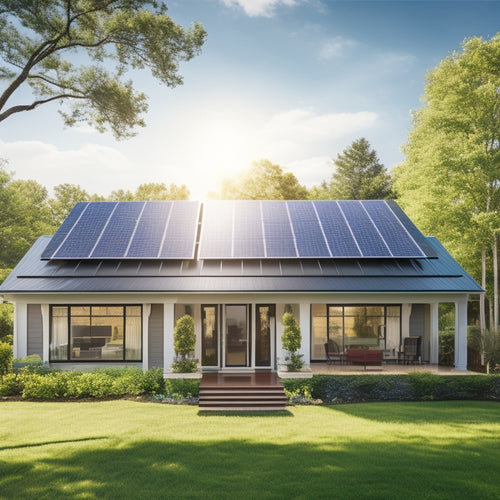
7 Tips to Lower Business Energy Costs
Share
By implementing a few strategic changes, you can considerably lower your business's energy costs. Start by conducting an energy assessment to identify areas of inefficiency and set benchmarks for improvement. Then, upgrade to energy-efficient equipment, optimize your lighting and HVAC systems, and consider investing in solar panels. Implement energy-saving technologies, such as automation solutions and energy analytics, to further reduce consumption. Additionally, monitor and analyze your energy usage to identify waste and opportunities for improvement. Finally, cultivate an energy-saving culture within your organization by engaging employees and promoting sustainability. You're on the path to substantial energy savings - and there's more to investigate.
Overview
- Conduct energy audits to identify inefficiencies and monitor consumption to set benchmarks for improvement and track waste reduction.
- Upgrade to energy-efficient equipment, including LED lighting and smart thermostats, to reduce energy consumption and costs.
- Implement automation solutions using IoT applications and energy analytics to optimize overall energy usage and reduce peak energy demand.
- Invest in renewable energy sources, such as solar panels, to reduce reliance on traditional energy sources and lower energy bills.
- Foster employee engagement and develop an energy-saving culture through awareness campaigns, training sessions, and incentive programs.
Assess Your Business Energy Usage
Many businesses underestimate the significance of understanding their energy usage patterns, but doing so is crucial to identifying areas of inefficiency and opportunities for cost savings.
Conducting an energy audit helps you analyze your usage patterns, identifying peak demand periods and opportunities for behavioral changes. You'll gain knowledge into your consumption trends and how they impact your bottom line.
Implementing energy storage solutions, such as Deep Cycle batteries, can also help reduce costs and enhance energy autonomy. A thorough cost analysis will reveal areas where you can optimize your energy use, reducing costs and increasing efficiency.
By engaging your employees in this process, you'll encourage a culture of sustainability and responsibility. Compare utility rates to verify you're getting the best deal, and investigate energy incentives that can help offset the cost of efficiency upgrades.
Optimize Lighting and HVAC Systems
You can considerably reduce your business's energy costs by optimizing your lighting and HVAC systems.
By upgrading to LED lighting, which uses considerably less energy than traditional lighting options, you can cut your energy consumption.
Moreover, implementing smart thermostat controls and regular system maintenance can help you identify and address energy-wasting inefficiencies.
In addition, incorporating energy efficient smart thermostats, as mentioned in Energy Efficiency Technologies, can also help automate temperature control and reduce peak energy consumption.
LED Lighting Upgrades
How much energy do your existing lighting systems consume? Upgrading to LED lighting can greatly reduce your energy costs. The installation process is relatively straightforward, and the benefits are numerous. LED lighting technology is highly energy-efficient, using up to 90% less energy than traditional lighting sources.
| Lighting Type | Energy Efficiency | Lifespan |
|---|---|---|
| Incandescent | 2-5% | 1,000-2,000 hours |
| Fluorescent | 50-70% | 8,000-10,000 hours |
| LED | 80-90% | 25,000-50,000 hours |
| Halogen | 20-30% | 2,000-4,000 hours |
| High-Intensity Discharge (HID) | 35-50% | 10,000-20,000 hours |
With LED lighting, you can expect a considerable return on investment through cost savings, improved workspace aesthetics, and enhanced business branding. Additionally, LED lighting promotes employee productivity, reduces environmental impact, and guarantees electrical safety.
Smart Thermostat Controls
What's holding your business back from achieving ideal energy efficiency? One key area to focus on is your thermostat settings.
By installing a smart thermostat, you can optimize your temperature control and energy schedules to match your business's unique usage patterns. These programmable features allow you to automate temperature adjustments, so you're not wasting energy when the building is unoccupied.
Additionally, incorporating high-efficiency solar charging solutions off-grid energy systems can further reduce your energy costs. Plus, with remote access, you can adjust the temperature from anywhere, using user-friendly interfaces on your smartphone or computer.
When installing a smart thermostat, consider the following tips: choose a model that integrates with your existing HVAC system, and consider hiring a professional for installation to guarantee it's done correctly.
Regular System Maintenance
Flickering fluorescent lights and clogged air vents are common culprits of energy inefficiency in commercial buildings.
Regular system maintenance is essential to optimize your lighting and HVAC systems, reducing energy consumption and costs. You can start by implementing maintenance schedules to guarantee that your systems are running efficiently. This includes tasks such as cleaning or replacing air filters, inspecting and replacing light bulbs, and performing system upgrades.
By doing so, you'll be able to identify and fix issues before they become major problems, reducing downtime and energy waste. Regular maintenance also helps extend the lifespan of your equipment, delaying the need for costly replacements.
Upgrade to Energy-Efficient Equipment
You can greatly reduce your business's energy consumption by upgrading to energy-efficient equipment.
Conducting energy audits helps identify areas where energy-efficient equipment can make the most impact. Consider equipment financing options to spread the cost over time.
Replace traditional lighting with LED lighting, which uses considerably less energy. Upgrade to energy-efficient HVAC systems, motors, and pumps to reduce energy consumption.
Look for equipment with the ENERGY STAR label, which indicates that it meets energy efficiency standards set by the U.S. Environmental Protection Agency.
Implement Energy-Saving Technologies
Upgrading to energy-efficient equipment is just the starting point for reducing your business's energy consumption.
To further optimize your energy usage, consider implementing energy-saving technologies. Conduct an energy audit to identify areas of improvement and investigate technology incentives to offset the cost.
Invest in automation solutions that utilize IoT applications and energy analytics to optimize your energy management. Implement demand response strategies to reduce peak usage and consider renewable options to minimize your carbon footprint.
Additionally, look into smart building technologies that can optimize power factor and grid integration.
Invest in Solar Panel Installation
Your business's energy consumption can be considerably reduced by utilizing the power of solar energy.
Investing in solar panel installation can provide significant financial savings in the long run. You can take advantage of solar incentives, such as tax credits and rebates, to offset the initial installation costs.
Additionally, solar panels require minimal maintenance and can last for up to 30 years, making them a reliable source of energy.
By tapping into the power of the sun, you can reduce your reliance on traditional energy sources and lower your energy bills.
With solar energy, you can enjoy a cleaner, more sustainable, and cost-effective way to power your business.
Monitor and Analyze Energy Consumption
You need to monitor and analyze your business's energy consumption to identify areas for improvement.
By tracking your energy usage patterns, you'll be able to pinpoint areas where energy is being wasted and set energy benchmarks to measure progress.
This data will enable you to make informed decisions about energy-saving upgrades and optimizations.
Track Energy Usage Patterns
Tracking energy usage patterns is essential to understanding how your business consumes energy, identifying areas of inefficiency, and pinpointing opportunities for cost-cutting measures.
By conducting regular energy audits, you can analyze your energy usage patterns to forecast future consumption. This behavioral analysis helps identify peak consumption periods, enabling you to develop strategies to reduce energy waste.
Engage your employees in energy-saving efforts by sharing data visualization of your energy usage, highlighting areas for improvement.
Consider investing in renewable sources and exploring demand response programs to optimize your energy usage.
Take advantage of utility incentives and cost comparisons to make informed decisions about your energy suppliers.
Identify Energy-Wasting Areas
Identifying energy-wasting areas within your business operations is essential to pinpointing opportunities for cost savings. You can accomplish this by conducting energy audits to identify areas of inefficiency.
These audits will help you develop a thorough energy management plan, which may include employee training on energy efficient habits, upgrading to energy-efficient equipment, and improving building insulation.
Additionally, you may be eligible for utility incentives for implementing energy-saving measures. By analyzing your energy consumption patterns, you can identify opportunities for improvement and prioritize energy assessments to optimize your energy usage.
This proactive approach will help you make informed decisions about equipment upgrades and other energy-saving initiatives, ultimately leading to significant cost savings.
Set Energy Benchmarks
Having pinpointed areas of energy inefficiency, it's now time to establish a baseline for energy consumption.
You'll need to set energy goals and performance metrics to track your progress. Start by benchmarking your current energy usage against industry standards and utility comparisons.
Conduct a cost analysis to identify areas where you can optimize energy consumption. Analyze usage trends to pinpoint opportunities for improvement.
Set efficiency targets and track your progress through regular consumption reports. By monitoring and analyzing your energy consumption, you'll be able to identify opportunities to reduce energy waste and lower your costs.
This data-driven approach will help you make informed decisions about energy efficiency upgrades and optimize your energy usage over time.
Develop an Energy-Saving Culture
One vital aspect of reducing business energy costs is creating an energy-saving culture within your organization. This involves encouraging employee engagement through awareness campaigns, team challenges, and designating energy champions to promote green practices.
You can also provide training sessions to educate staff on your sustainability goals and the role they play in achieving them. Incentive programs can be implemented to motivate employees to take action. Develop collaborative initiatives that cultivate a sense of responsibility among team members.
Effective communication strategies are essential in promoting your organization's commitment to reducing energy costs. By developing an energy-saving culture, you'll be well on your way to achieving significant cost savings and contributing to a more sustainable future.
Frequently Asked Questions
How Often Should I Replace Air Filters to Maintain Optimal Efficiency?
You should replace air filters every 1-3 months, depending on the type, such as pleated, HEPA, or fiberglass, and maintain a regular schedule to guarantee peak efficiency, as dirty filters increase energy consumption and reduce airflow.
Can Energy-Efficient Upgrades Be Deducted From Business Taxes?
You'll be pleased to know that yes, energy-efficient upgrades can be deducted from business taxes, providing significant tax benefits and energy incentives that enhance your bottom line and support your pursuit of financial freedom.
Do Energy-Saving Measures Negatively Impact Employee Productivity?
You'll be intrigued to know that 68% of employees report higher productivity when they're comfortable in their workspace. Implementing energy-saving measures doesn't have to compromise employee comfort; it's about striking a balance between the two to enhance overall productivity.
Can I Install Solar Panels on a Rented Commercial Property?
You'll need to review your rental property agreements and research local solar panel regulations to determine if installing solar panels is feasible, as some agreements may restrict modifications and regulations may dictate specific installation requirements.
Are Energy Audits Only Necessary for Large Businesses?
You think energy audits are only for corporate giants, but surprise! They're a revolutionary development for small businesses too, uncovering hidden opportunities to slash energy waste and enhance profits - it's like finding free money hidden in your walls!
Ready to Buy
You've taken the first step towards reducing your business energy costs by implementing these 7 tips. Now, assess and optimize, upgrade and implement, invest and monitor, and develop a culture that saves energy. By doing so, you'll not only cut costs but also reduce your carbon footprint. As you move forward, remember that every small change adds up to make a big difference in your bottom line and the environment.
Related Posts
-

Smart Home Thermostats to Revolutionize Your Space
Smart home thermostats revolutionize your space by providing precise temperature control and optimizing energy saving...
-

Replacing Old Appliances With Sustainable Alternatives
Replacing old appliances with sustainable alternatives can change your home into an energy-efficient space. Not only ...
-

Home Solar Installation Cost
You're considering installing solar panels on your home, and the upfront cost is likely the biggest hurdle standing i...


